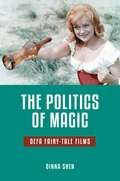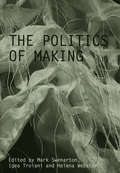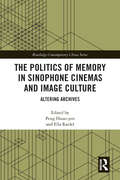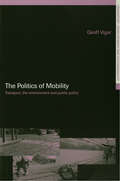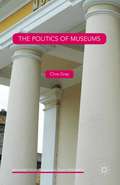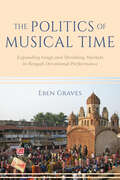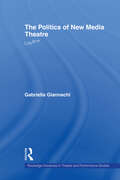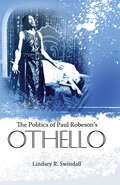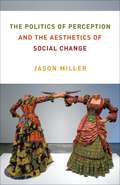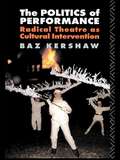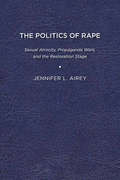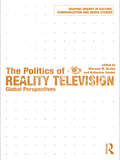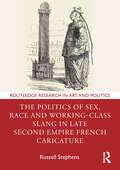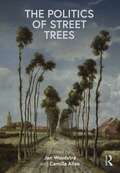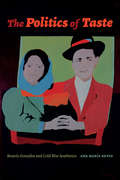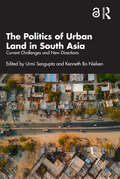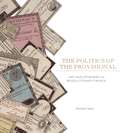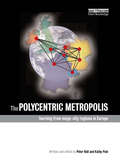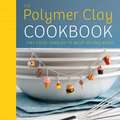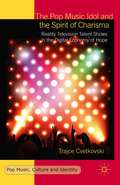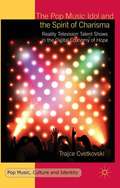- Table View
- List View
The Politics of Magic: DEFA Fairy-Tale Films (Series in Fairy-Tale Studies)
by Qinna ShenFrom Paul Verhoeven's The Cold Heart in 1950 to Konrad Petzold's The Story of the Goose Princess and Her Loyal Horse Falada in 1989, East Germany's state-sponsored film company, DEFA (Deutsche Film-Aktiengesellschaft), produced over forty feature-length, live-action fairy-tale films based on nineteenth-century folk and literary tales. While many of these films were popular successes and paved the way for the studio's other films to enter the global market, DEFA's fairy-tale corpus has not been studied in its entirety. In The Politics of Magic: DEFA Fairy-Tale Films, Qinna Shen fills this gap by analyzing the films on thematic and formal levels and examining their embedded agendas in relation to the cultural politics of the German Democratic Republic. In five chapters, Shen compares the films with earlier print versions of the same stories and analyzes revisions made in DEFA's film adaptations. She also distinguishes the DEFA fairy-tale films from National Socialist, West German, and Disney adaptations of the same tales. Her archival work reconstitutes the cultural-historical context in which films were produced and received, and incorporates the films into the larger narrative of DEFA. For the first time, the banned DEFA fairy-tale comedy, The Robe (1961/1991), is discussed in depth. The book's title The Politics of Magic is not intended to suggest that DEFA fairy-tale films were merely mouthpieces of official ideology and propaganda. On the contrary, Shen shows that the films run the gamut from politically dogmatic to implicitly subversive, from kitschy to experimental. She argues that the fairy-tale cloak permitted them to convey ideology in a subtle, indirect manner that allowed viewers to forget Cold War politics for a while and to delve into a world of magic where politics took on an allegorical form. The fact that some DEFA fairy-tale films developed an international audience (particularly The Story of Little Mook and Three Hazelnuts for Cinderella) not only attests to these films' universal appeal but also to the surprising marketability of this branch of GDR cinema and its impact beyond the GDR's own narrow temporal and geographic boundaries. Shen's study will be significant reading for teachers and students of folklore studies and for scholars of German, Eastern European, cultural, film, media, and gender studies.
The Politics of Making: Book Of Abstracts: 3rd Annual Architectural Humanities Research Association International Conference: St. Catherine's College, Oxford 17-18 November 2006
by Igea Troiani Mark Swenarton Helena WebsterA unique collection of contemporary writings, this book explores the politics involved in the making and experiencing of architecture and cities from a cross-cultural and global perspective Taking a broad view of the word ‘politics’, the essays address a range of questions, including: What is the relationship between politics and the making of space? What role has theory played in reinforcing or resisting political power? What are the political difficulties associated with working relationships? Do the products of our making construct our identity or liberate us? A timely volume, focusing on an interdisciplinary debate on the politics of making, this is valuable reading for all students, professionals and academics interested or working in architectural theory.
The Politics of Memory in Sinophone Cinemas and Image Culture: Altering Archives (Routledge Contemporary China Series)
by Peng Hsiao-Yen Ella RaidelCinema archives memories, conserves the past, and rewrites histories. As much as the Sinophone embodies differences, contemporary Sinophone cinemas in Taiwan, Hong Kong, and the People’s Republic of China invest various images of contested politics in order to assert different histories and self-consciousness. As such, Sinophone cinemas and image production function as archives, with the capability of reinterpreting the multiple dimensions of past and present. The Politics of Memory in Sinophone Cinemas and Image Culture investigates Sinophone films and art projects that express this desire for archiving and reconfiguring the past. Comprising ten chapters, this book brings together contributors from an array of disciplines - artists, filmmakers, curators, film critics, and literary scholars - to grapple with the creative ambiguities of Sinophone cinemas and image culture. Blending eclectic methods of scholarly research, knowledge-making, and art-making into a new discursive space, the chapters address the diverse complexities of the cinematic culture and image production in Sinitic language regions. This book is a valuable resource for students and scholars of film studies, China studies, East Asian studies, Taiwan studies, and Sinophone studies, as well as professionals who work in the film industry.
The Politics of Mobility: Transport Planning, the Environment and Public Policy (Transport, Development and Sustainability Series)
by Geoff VigarTransport issues are critically embedded in everyday life. For this very reason, ways of addressing such issues are almost always hugely politically contentious, as a quick glance at local and national media will testify. Such contentiousness is growing as ever increasing mobility for many in western society has led to a critical examination of the fundamental basis by which transport issues are considered in government and beyond. Despite the strength of this examination, the implementation of new approaches to dealing with transport issues has proved deeply problematic. The Politics of Mobility pioneers a methodological and theoretical framework derived from the social and political sciences to shed light on the complexities of dealing with these issues. It mobilises three case studies that highlight the realpolitik of dealing with such concerns for students, practitioners, researchers and activists.
The Politics of Museums (New Directions in Cultural Policy Research)
by Clive GrayThis is the first book to examine how and why museums are political institutions. By concentrating on the ways in which power, ideology and legitimacy work at the international, national and local levels of the museum experience, Clive Gray provides an original analysis of who exercises power and how power is used in museums.
The Politics of Musical Time: Expanding Songs and Shrinking Markets in Bengali Devotional Performance
by Eben GravesHow do the temporal features of sacred music affect social life in South Asia? Due to new time constraints in commercial contexts, devotional musicians in Bengal have adapted longstanding features of musical time linked with religious practice to promote their own musical careers.The Politics of Musical Time traces a lineage of singers performing a Hindu devotional song known as kīrtan in the Bengal region of India over the past century to demonstrate the shifting meanings and practices of devotional performance. Focusing on padābalī kīrtan, a type of devotional sung poetry that uses long-duration forms and combines song and storytelling, Eben Graves examines how expressions of religious affect and political belonging linked with the genre become strained in contemporary, shortened performance time frames. To illustrate the political economy of performance in South Asia, Graves also explores how religious performances and texts interact with issues of nationalism, gender, and economic exchange.Combining ethnography, history, and performance analysis, including videos from the author's fieldwork, The Politics of Musical Time reveals how ideas about the sacred and the modern have been expressed and contested through features of musical time found in devotional performance.
The Politics of New Media Theatre: Life®™ (Routledge Advances in Theatre & Performance Studies #Vol. 6)
by Gabriella GiannachiThe first book in the field to explore the links between theories of globalization and surveillance, bipower and biopolitics, performance and theatre, computer arts and politics, "The Politics of New Media Theatre" is an investigation into the political role played by the new media theatre. Gabriella Giannachi explores how new media arts constitute themselves as a radical political movement, and presents an analysis of both the role of virtuality in radical performance and politics in virtual and mixed reality practices. This outstanding new work offers an analysis of leading political, philosophical and artistic texts and artworks, and represents a milestone for anyone interested in new technologies, theatre and politics.
The Politics of Paul Robeson's Othello (Margaret Walker Alexander Series in African American Studies)
by Lindsey R. SwindallLindsey R. Swindall examines the historical and political context of acclaimed African American actor Paul Robeson’s three portrayals of Shakespeare’s Othello in the United Kingdom and the United States. These performances took place in London in 1930, on Broadway in 1943, and in Stratford-upon-Avon in 1959. All three of the productions, when considered together, provide an intriguing glimpse into Robeson’s artistry as well as his political activism. The Politics of Paul Robeson’s Othello maintains that Robeson’s development into a politically minded artist explicates the broader issue of the role of the African American artist in times of crisis. Robeson (1898–1976) fervently believed that political engagement was an inherent component of the role of the artist in society, and his performances demonstrate this conviction. In the 1930 production, audiences and critics alike confronted the question: Should a Black actor play Othello in an otherwise all-white cast? In the 1943 production on Broadway, Robeson consciously used the role as a form for questioning theater segregation both onstage and in the seats. In 1959, after he had become well known for his leftist views and sympathies with Communism, his performance in a major Stratford-upon-Avon production called into question whether audiences could accept onstage an African American who held radical—and increasingly unpopular—political views. Swindall thoughtfully uses Robeson’s Othello performances as a collective lens to analyze the actor and activist’s political and intellectual development.
The Politics of Perception and the Aesthetics of Social Change (Columbia Themes in Philosophy, Social Criticism, and the Arts)
by Jason MillerIn both politics and art in recent decades, there has been a dramatic shift in emphasis on representation of identity. Liberal ideals of universality and individuality have given way to a concern with the visibility and recognition of underrepresented groups. Modernist and postmodernist celebrations of disruption and subversion have been challenged by the view that representation is integral to social change. Despite this convergence, neither political nor aesthetic theory has given much attention to the increasingly central role of art in debates and struggles over cultural identity in the public sphere.Connecting Hegelian aesthetics with contemporary cultural politics, Jason Miller argues that both the aesthetic and political value of art are found in the reflexive self-awareness that artistic representation enables. The significance of art in modern life is that it shows us both the particular element in humanity as well as the human element in particularity. Just as Hegel asks us to acknowledge how different historical and cultural contexts produce radically different experiences of art, identity-based art calls on its audiences to situate themselves in relation to perspectives and experiences potentially quite remote—or even inaccessible—from their own. Miller offers a timely response to questions such as: How does contemporary art’s politics of perception contest liberal notions of deliberative politics? How does the cultural identity of the artist relate to the representations of cultural identity in their work? How do we understand and evaluate identity-based art aesthetically?Discussing a wide range of works of art and popular culture—from Antigone to Do the Right Thing and The Wire—this book develops a new conceptual framework for understanding the representation of cultural identity that affirms art’s capacity to effect social change.
The Politics of Performance: Radical Theatre as Cultural Intervention
by Baz KershawThe Politics of Performance^ addresses fundamental questions about the social and political purposes of performance through an investigation into post-war alternative and community theatre. It proposes a theory of performace as ideological transaction, cultural intervention and community action, which is used to illuminate the potential social and political effects of radical performance practice. It raises issues about the nature of alternative theatre as a movement and the aesthetics of its styles of production, especially in relation to progressive counter-cultural formations. It analyses in detail the work of key practitioners in socially engaged theatre during four decades, setting each in the context of social, political and cultural history and focusing particularly on how they used that context to enhance the potential efficacy of their productions. The book is thus a detailed analysis of oppositional theatre as radical cultural practice in its various efforts to subvert the status quo. Its purpose is to raise the profile of these approaches to performance by proposing, and demonstrating how they may have had a significant impact on social and political history.
The Politics of Public Space in Republican Rome
by Amy RussellTaking public space as her starting point, Amy Russell offers a fresh analysis of the ever-fluid public/private divide in Republican Rome. Built on the 'spatial turn' in Roman studies and incorporating textual and archaeological evidence, this book uncovers a rich variety of urban spaces. No space in Rome was solely or fully public. Some spaces were public but also political, sacred, or foreign; many apparently public spaces were saturated by the private, leaving grey areas and room for manipulation. Women, slaves, and non-citizens were broadly excluded from politics: how did they experience and help to shape its spaces? How did the building projects of Republican dynasts relate to the communal realm? From the Forum to the victory temples of the Campus Martius, culminating in Pompey's great theatre-portico-temple-garden-house complex, The Politics of Public Space in Republican Rome explores how space was marked, experienced, and defined by multiple actors and audiences.
The Politics of Rape: Sexual Atrocity, Propaganda Wars, and the Restoration Stage
by Jennifer L. AireyThe Politics of Rape: Sexual Atrocity, Propaganda Wars, and the Restoration Stage is the first full-length study to examine representations of sexual violence on the Restoration stage. By reading theatrical depictions of sexual violence alongside political tracts, propaganda pamphlets, and circulating broadsides, this study argues that authors used dramatic representations of rape to respond to and engage with late-century upheavals in British political culture. Beginning with an examination of rape scenes in English Civil War propaganda, The Politics of Rape argues that Roundhead authors described acts of rape and atrocity to demonize their enemies, the Irish, the Catholics, and the Cavaliers. After the Restoration, propagandists and playwrights on each side of every political conflict would follow suit, altering the rhetoric of sexual violence in response to each new moment of political upheaval: The Restoration of Charles II, the Second and Third Anglo-Dutch Wars, the Popish Plot, the Exclusion Crisis, the Glorious Revolution, and the accession of William and Mary. The study offers an intensive look at British propaganda culture, gathering together a wealth of understudied pamphlet texts, and identifying a series of stock figures that recur throughout the century: The demonic Irishman, sexually violent villain of the 1641 Irish Rebellion tracts; the debauched Cavalier, the secretly Catholic royalist rapist; the poisonous Catholic bride, the malignant consort who encourages the rapes of Protestant women; the cannibal father, the evil patriarch who rapes his daughters-in-laws before ingesting his own sons as a symbol of monarchical overreach; and the ravished monarch, the male rape victim whose sexual violation protests his political disenfranchisement. The study also traces the appearance of these figures on the British stage, examining well-known works by Dryden, Rochester, Behn, Lee, and Shadwell, alongside lesser-known plays by Orrery, Howard, Settle, Crowne, Ravenscroft, Pix, Cibber, and Brady. The Politics of Rape thus offers a new method for understanding of the geo-political implications of theatrical sexual violence. Published by University of Delaware Press. Distributed worldwide by Rutgers University Press.
The Politics of Rape: Sexual Atrocity, Propaganda Wars, and the Restoration Stage
by Jennifer L. AireyThe Politics of Rape: Sexual Atrocity, Propaganda Wars, and the Restoration Stage is the first full-length study to examine representations of sexual violence on the Restoration stage. By reading theatrical depictions of sexual violence alongside political tracts, propaganda pamphlets, and circulating broadsides, this study argues that authors used dramatic representations of rape to respond to and engage with late-century upheavals in British political culture. Beginning with an examination of rape scenes in English Civil War propaganda, The Politics of Rape argues that Roundhead authors described acts of rape and atrocity to demonize their enemies, the Irish, the Catholics, and the Cavaliers. After the Restoration, propagandists and playwrights on each side of every political conflict would follow suit, altering the rhetoric of sexual violence in response to each new moment of political upheaval: The Restoration of Charles II, the Second and Third Anglo-Dutch Wars, the Popish Plot, the Exclusion Crisis, the Glorious Revolution, and the accession of William and Mary. The study offers an intensive look at British propaganda culture, gathering together a wealth of understudied pamphlet texts, and identifying a series of stock figures that recur throughout the century: The demonic Irishman, sexually violent villain of the 1641 Irish Rebellion tracts; the debauched Cavalier, the secretly Catholic royalist rapist; the poisonous Catholic bride, the malignant consort who encourages the rapes of Protestant women; the cannibal father, the evil patriarch who rapes his daughters-in-laws before ingesting his own sons as a symbol of monarchical overreach; and the ravished monarch, the male rape victim whose sexual violation protests his political disenfranchisement. The study also traces the appearance of these figures on the British stage, examining well-known works by Dryden, Rochester, Behn, Lee, and Shadwell, alongside lesser-known plays by Orrery, Howard, Settle, Crowne, Ravenscroft, Pix, Cibber, and Brady. The Politics of Rape thus offers a new method for understanding of the geo-political implications of theatrical sexual violence. Published by University of Delaware Press. Distributed worldwide by Rutgers University Press.
The Politics of Reality Television: Global Perspectives (Shaping Inquiry in Culture, Communication and Media Studies)
by Marwan M. KraidyThe Politics of Reality Television encompasses an international selection of expert contributions who consider the specific ways media migrations test our understanding of, and means of investigating, reality television across the globe. The book addresses a wide range of topics, including: the global circulation and local adaptation of reality television formats and franchises the production of fame and celebrity around hitherto "ordinary" people the transformation of self under the public eye the tensions between fierce loyalties to local representatives and imagined communities bonding across regional and ethnic divides the struggle over the meanings and values of reality television across a range of national, regional, gender, class and religious contexts. This book will be of interest to undergraduate and postgraduate students on a range of Media and Television Studies courses, particularly those on the globalisation of television and media, and reality television.
The Politics of Sex, Race and Working-Class Slang in Late Second Empire French Caricature (Routledge Research in Art and Politics)
by Russell StephensThis study examines caricatures as they appeared within popular Parisian magazines in mid-19th century France at the time of the 1867 World’s Fair. Chapters compare the comic mockery of several of the most important satirists of this time, including Amédée de Noé, or “Cham” (1818–1879) as he was more popularly known, and Honoré Daumier (1808–1879). A major theme within the analysis is how these caricaturists secretly used argot (street slang), as documented in two slang dictionaries by Parisian litterateur, Alfred Delvau (1825–1867), within their comic images to carry hidden encrypted messages in order to evade the censorship of the day. The book focuses primarily on caricatures of Chinese visitors who were part of the 1866 diplomatic visit to Paris and images of Chinese at the 1867 Exposition Universelle, showing how the satires which were published by Cham used argot to create highly sexualised images that were often racist in nature. In contrast, the volume proposes that Daumier used slang in his caricatures to challenge racism and to make secret reference to current political leaders and politics. The book will be of interest to scholars working in art history, visual culture, media studies, and communication studies.
The Politics of Street Trees
by Jan WoudstraThis book focuses on the politics of street trees and the institutions, actors and processes that govern their planning, planting and maintenance. This is an innovative approach which is particularly important in the context of mounting environmental and societal challenges and reveals a huge amount about the nature of modern life, social change and political conflict. The work first provides different historical perspectives on street trees and politics, celebrating diversity in different cultures. A second section discusses street tree values, policy and management, addressing more contemporary issues of their significance and contribution to our environment, both physically and philosophically. It explores cultural idiosyncrasies and those from the point of view of political economy, particularly challenging the neo-liberal perspectives that continue to dominate political narratives. The final section provides case studies of community engagement, civil action and governance. International case studies bring together contrasting approaches in areas with diverging political directions or intentions, the constraints of laws and the importance of people power. By pursuing an interdisciplinary approach this book produces an information base for academics, practitioners, politicians and activists alike, thus contributing to a fairer political debate that helps to promote more democratic environments that are sustainable, equitable, comfortable and healthier.
The Politics of Taste: Beatriz González and Cold War Aesthetics (Art History Publication Initiative)
by Ana María ReyesIn The Politics of Taste Ana María Reyes examines the works of Colombian artist Beatriz González and Argentine-born art critic, Marta Traba, who championed González's art during Colombia's National Front coalition government (1958–74). During this critical period in Latin American art, artistic practice, art criticism, and institutional objectives came into strenuous yet productive tension. While González&’s triumphant debut excited critics who wanted to cast Colombian art as modern, sophisticated, and universal, her turn to urban lowbrow culture proved deeply unsettling. Traba praised González's cursi (tacky) recycling aesthetic as daringly subversive and her strategic localism as resistant to U.S. cultural imperialism. Reyes reads González's and Traba's complex visual and textual production and their intertwined careers against Cold War modernization programs that were deeply embedded in the elite's fear of the masses and designed to avert Cuban-inspired revolution. In so doing, Reyes provides fresh insights into Colombia's social anxieties and frustrations while highlighting how interrogations of taste became vital expressions of the growing discontent with the Colombian state.
The Politics of Urban Land in South Asia: Current Challenges and New Directions (Cities and the Urban Imperative)
by Kenneth Bo Nielsen Urmi SenguptaCities in South Asia are homes to one of the highest concentrations of people anywhere in the world and the allocation of land and urban resources and the benefits that can be derived from them in this region have become increasingly contested. This book explores the politics of urban land in South Asia and the challenges related to their respective urban futures.For most people, land comes at a premium, and as a result conflicts and contestations over land and urban resources are rife in countries such as India, Bangladesh, Pakistan, Sri Lanka and Nepal, as witnessed in the many struggles of low-income groups and vulnerable or marginalised communities to fight off dispossession or displacement. This book maps current challenges shared across national borders and charts out new directions for future research and land policy. With contributions from emerging and established authors, the book offers a critical accounting of the situation that exists in urban South Asia, while also critically engaging with the current challenges and future directions for land use and land politics.The book will be useful to students and researchers of public policy, development studies, economics, urban and regional development studies, and sociology as well as to policy makers, real estate professionals, and commercial firms engaged in property market/real estate study in Asia.Chapter 10 of this book is freely available as a downloadable Open Access PDF at http://www.taylorfrancis.com under a Creative Commons [Attribution-Non Commercial-No Derivatives CC-BY-NC-ND 4.0 license.
The Politics of Water in the Art and Festivals of Medici Florence: From Neptune Fountain to Naumachia (European Festival Studies: 1450-1700)
by Felicia M. ElseThis book tells the story of one dynasty's struggle with water, to control its flow and manage its representation. The role of water in the art and festivals of Cosimo I and his heirs, Francesco I and Ferdinando I de' Medici, informs this richly-illustrated interdisciplinary study. Else draws on a wealth of visual and documentary material to trace how the Medici sought to harness the power of Neptune, whether in the application of his imagery or in the control over waterways and maritime frontiers, as they negotiated a place in the unstable political arena of Europe, and competed with foreign powers more versed in maritime traditions and aquatic imagery.
The Politics of the Provisional: Art and Ephemera in Revolutionary France
by Richard TawsIn revolutionary France the life of things could not be assured. War, shortage of materials, and frequent changes in political authority meant that few large-scale artworks or permanent monuments to the Revolution’s memory were completed. On the contrary, visual practice in revolutionary France was characterized by the production and circulation of a range of transitional, provisional, ephemeral, and half-made images and objects, from printed paper money, passports, and almanacs to temporary festival installations and relics of the demolished Bastille. Addressing this mass of images conventionally ignored in art history, The Politics of the Provisional contends that they were at the heart of debates on the nature of political authenticity and historical memory during the French Revolution. Thinking about material durability, this book suggests, was one of the key ways in which revolutionaries conceptualized duration, and it was crucial to how they imagined the Revolution’s transformative role in history.The Politics of the Provisional is the first book in the Art History Publication Initiative (AHPI), a collaborative grant from the Andrew W. Mellon Foundation. Thanks to the AHPI grant, this book is available on a variety of popular e-book platforms.
The Politics of the Provisional: Art and Ephemera in Revolutionary France
by Richard TawsIn revolutionary France the life of things could not be assured. War, shortage of materials, and frequent changes in political authority meant that few large-scale artworks or permanent monuments to the Revolution’s memory were completed. On the contrary, visual practice in revolutionary France was characterized by the production and circulation of a range of transitional, provisional, ephemeral, and half-made images and objects, from printed paper money, passports, and almanacs to temporary festival installations and relics of the demolished Bastille. Addressing this mass of images conventionally ignored in art history, The Politics of the Provisional contends that they were at the heart of debates on the nature of political authenticity and historical memory during the French Revolution. Thinking about material durability, this book suggests, was one of the key ways in which revolutionaries conceptualized duration, and it was crucial to how they imagined the Revolution’s transformative role in history.The Politics of the Provisional is the first book in the Art History Publication Initiative (AHPI), a collaborative grant from the Andrew W. Mellon Foundation. Thanks to the AHPI grant, this book is available on a variety of popular e-book platforms.
The Polycentric Metropolis: Learning from Mega-City Regions in Europe
by Peter Hall Kathy PainA new 21st century urban phenomenon is emerging: the networked polycentric mega-city region. Developed around one or more cities of global status, it is characterized by a cluster of cities and towns, physically separate but intensively networked in a complex spatial division of labour. This book describes and analyses eight such regions in North West Europe. For the first time, this work shows how businesses interrelate and communicate in geographical space - within each region, between them, and with the wider world. It goes on to demonstrate the profound consequences for spatial planning and regional development in Europe - and, by implication, other similar urban regions of the world. The Polycentric Metropolis introduces the concept of a mega-city region, analyses its characteristics, examines the issues surrounding regional identities, and discusses policy ramifications and outcomes for infrastructure, transport systems and regulation. Packed with high quality maps, case study data and written in a clear style by highly experienced authors, this will be an insightful and significant analysis suitable for professionals in urban planning and policy, environmental consultancies, business and investment communities, technical libraries, and students in urban studies, geography, economics and town/spatial planning.
The Polymer Clay Cookbook: Tiny Food Jewelry to Whip Up and Wear
by Susan Partain Jessica PartainThe Polymer Clay Cookbook celebrates favorite foods with 20 tiny, deliciously realistic food charms to make from polymer clay and fashion into unique jewelry. Styled as a cookbook for the beginning miniaturist "chef," the introductory chapters discuss the "basic ingredients" and techniques used for polymer clay and jewelry-making. The remainder of the book offers 20 "recipes" grouped by category: fruits, breakfast, lunch and dinner, sweets and snacks, and holiday foods. Each recipe has a list of "ingredients," step-by-step directions with photographs, and suggested variations. Each piece is presented as a particular finished jewelry item, such as a necklace, but readers are encouraged to adapt the piece into any type of jewelry they choose. Each chapter also includes one of the authors' own cherished recipes for real food, including Sunday Morning Cinnamon Rolls, Grandma's Pasta Sauce, Decadent Raspberry Chocolate Cupcakes, and Mom's Holiday Sugar Cookies. Throughout, the authors--who are sisters--share their enthusiasm for family, sisterhood, and the tradition and feelings surrounding our favorite foods.
The Pop Music Idol and the Spirit of Charisma: Reality Television Talent Shows in the Digital Economy of Hope (Pop Music, Culture and Identity)
by T. CvetkovskiThis book makes a case for the synergetic union between reality TV and the music industry. It delves into technological change in popular music, and the role of music reality TV and social media in the pop production process. It challenges the current scholarship which does not adequately distinguish the economic significance of these developments.
The Pop Music Idol and the Spirit of Charisma: Reality Television Talent Shows in the Digital Economy of Hope (Pop Music, Culture and Identity)
by Trajce CvetkovskiThis book makes a case for the synergetic union between reality TV and the music industry. It delves into technological change in popular music, and the role of music reality TV and social media in the pop production process. It challenges the current scholarship which does not adequately distinguish the economic significance of these developments.
